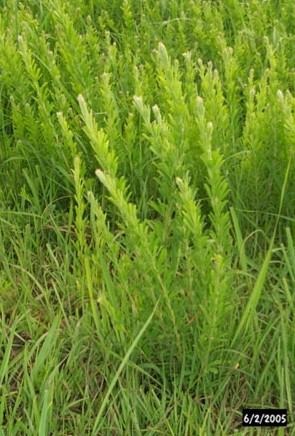Sericea lespedeza is a perennial legume with trifoliate leaves. The leaves are club or wedged shaped (Figure 2). Plants are usually about 3 feet tall, but can grow to several feet in height under ideal conditions. Plants will start to bloom in August with white to cream-colored flowers with a purple throat. Most seed production occurs in September.

Figure 2. Trifoliate, wedge-shaped leaflets of sericea lespedeza. Photo by Walt Fick, K-State Research and Extension.
June is a good time for control of sericea lespedeza using herbicides. At this time, sericea lespedeza is in a vegetative growth stage (Figure 3) and is rapidly growing. By the end of June plants will begin to branch and become woodier.

Figure 3. Vegetative growth stage of sericea lespedeza. Photo by Walt Fick, K-State Research and Extension.
Chemical control options
The most effective herbicides to treat sericea lespedeza during the vegetative growth stage are Remedy Ultra (triclopyr) and PastureGard HL (triclopyr + fluroxypyr). Broadcast applications of Remedy Ultra at 1 to 2 pints/acre and PastureGard HL at 0.75 to 1.5 pints/acre should be applied in spray volumes of 10 to 20 gallons/acre. Another herbicide option would be Surmount (picloram + fluroxypyr) at 2 pint/acre. Surmount is a restricted-use pesticide and would be a good choice if you are wanting to treat roughleaf dogwood or blackberry at the same time. Once sericea starts to branch, metsulfuron-containing herbicides such as Escort XP (0.5 to 1 oz/acre) can be effective.
For spot application, mix 0.5 fl oz PastureGard HL per gallon of water or use a 1% solution of Remedy Ultra in water. Aerial applications of these products should be done with a minimum spray volume of 3 gallons per acre. Higher volumes, e.g. 5 gallons per acre, will generally be more effective.
There are no grazing and haying restrictions for livestock and lactating grazing animals following use of Remedy Ultra and PastureGard HL. There is a 14-day waiting period prior to hay harvest using these two herbicides. If Surmount is used, there is no waiting period before grazing all livestock, except for lactating dairy animals (14-days before grazing). Surmount also requires a 14-day waiting period prior to hay harvest. There are no grazing or haying restrictions following application of Escort XP.
As a noxious weed in Kansas, sericea lespedeza needs to be controlled. Sericea lespedeza has a tremendous seed bank that helps reestablish stands.
Herbicide treatments will need to be repeated every 2 to 4 years to keep this invasive species in check. Initial treatments should reduce dense stands to the point where spot treatment can be used in future years. Left untreated, sericea lespedeza will dominate a site, greatly reducing forage production and species diversity.
Source : ksu.edu